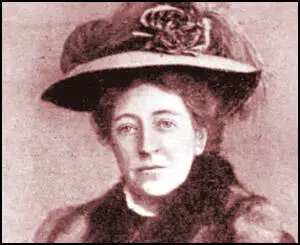Margaret Ashton

Margaret Ashton was born in Withington on 19th January 1856. She was the third of the six daughters and three sons of Thomas Ashton, a wealthy cotton manufacturer. Her father, was a Unitarian and an active member of the Liberal Party, and held progressive views on social reform.
In 1870 Ashton worked closely with Samuel Fielden, in raising money for Owens College, the Nonconformist education establishment founded in Manchester by the cotton-merchant, John Owens. By 1870 Fielden and Ashton had raised £200,000 for the college.
As her biographer, Peter D. Mohr, points out: "From 1875 Margaret Ashton worked on a voluntary basis as the manager of the Flowery Fields School in Hyde, which had been founded by her grandfather, for the children of mill workers. Her first involvement in politics came in 1888, when she helped to found the Manchester Women's Guardian Association, an organization which encouraged women to become poor-law guardians and to take a more active role in local politics."
Elizabeth Crawford, the author of The Suffragette Movement (1999) claims that "her father refused her request to be taken into the family business, although she was able to concern herself with its welfare policy." In 1895 Margaret joined the Women's Liberal Federation, and the following year became a founder member of the Women's Trade Union League. She was also a member of the National Union of Women Suffrage Societies.
After the death of her father, Thomas Ashton, in 1898, Margaret became more active in politics and in 1900 she was elected to the Withington Urban District Council. Eight years later she became the first woman to the Manchester City Council. According to Peter D. Mohr: "As a councillor she devoted herself to the issues of women's health and education, and campaigned to improve the conditions of employment for women. She supported new legislation to improve the wages and conditions of factory girls, to raise the age of employment of children, and to abolish the sweated system."
In 1906 Margaret Ashton resigned from the Liberal Party when it became clear to her that Henry Campbell-Bannerman, decided that his government would not find time to allow legislation to be passed concerning women's suffrage. Ashton became chairperson of the North of England Society for Women's Suffrage, and financially supported its newspaper, The Common Cause.
Ashton remained committed to the use of constitutional methods to gain votes for women. Ashton, like other members of the NUWSS, feared that the militant actions of the Women's Social and Political Union (WSPU) would alienate potential supporters of women's suffrage. However, Ashton admired the courage of the suffragettes and in 1906 she joined with Millicent Fawcett and Lilias Ashworth Hallett in organizing the banquet at the Savoy to celebrate the release from Holloway Prison of WSPU prisoners.
In July 1914 the NUWSS argued that Asquith's government should do everything possible to avoid a European war. Two days after the British government declared war on Germany on 4th August 1914, Millicent Fawcett declared that it was suspending all political activity until the conflict was over. Although the NUWSS supported the war effort, it did not follow the WSPU strategy of becoming involved in persuading young men to join the armed forces.
Despite pressure from members of the NUWSS, Fawcett refused to argue against the First World War. Her biographer, Ray Strachey, argued: "She stood like a rock in their path, opposing herself with all the great weight of her personal popularity and prestige to their use of the machinery and name of the union." At a Council meeting of the National Union of Women's Suffrage Societies held in February 1915, Fawcett attacked the peace efforts of people like Mary Sheepshanks. Fawcett argued that until the German armies had been driven out of France and Belgium: "I believe it is akin to treason to talk of peace."
After a stormy executive meeting in Buxton all the officers of the NUWSS (except the Treasurer) and ten members of the National Executive resigned over the decision not to support the Women's Peace Congress at the Hague. This included Ashton, Chrystal Macmillan, Kathleen Courtney, Catherine Marshall, Eleanor Rathbone and Maude Royden, the editor of the The Common Cause.
In April 1915, Aletta Jacobs, a suffragist in Holland, invited suffrage members all over the world to an International Congress of Women in the Hague. Some of the women who attended included Mary Sheepshanks, Jane Addams, Alice Hamilton, Grace Abbott, Emily Bach, Lida Gustava Heymann, Emmeline Pethick-Lawrence, Emily Hobhouse, Chrystal Macmillan, Rosika Schwimmer. At the conference the women formed the Women's International League for Peace and Freedom (WIL). Although the government blocked Ashton and other British women from travelling to the Hague, she immediately joined this organisation.
Margaret Ashton's pacifism made her unpopular during the First World War. Se was branded "pro-German" and ousted from Manchester City Council in 1921. Her civic work was never properly recognized; a portrait by Henry Lamb to commemorate her seventieth birthday was refused by the Manchester City Art Gallery as a protest against her pacifist views.
In later life she joined the National Council of Women, and helped to found the Manchester Women's Citizens Association.
Mary Ashton died at her home, 12 Kingston Road, Didsbury, on 15th October 1937.

